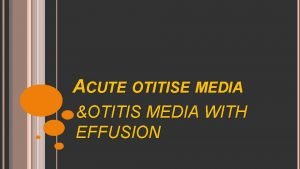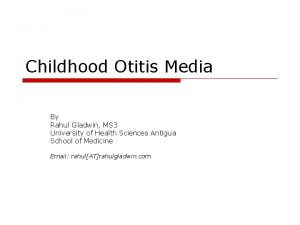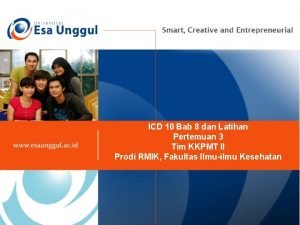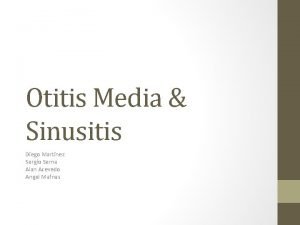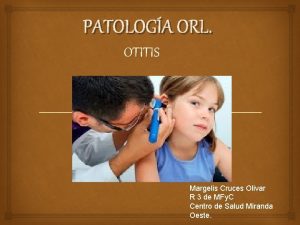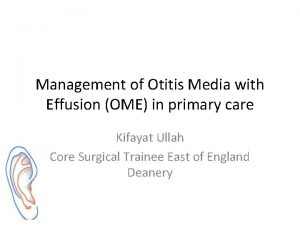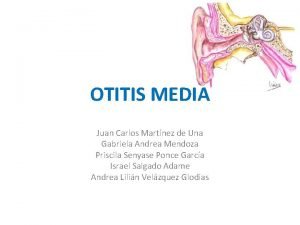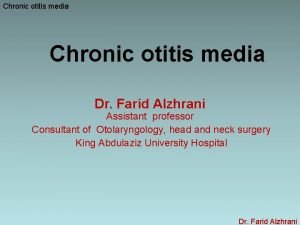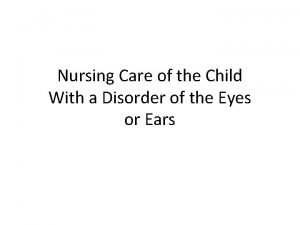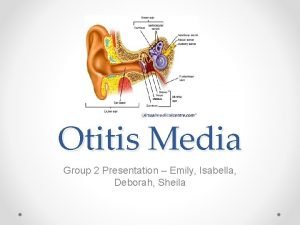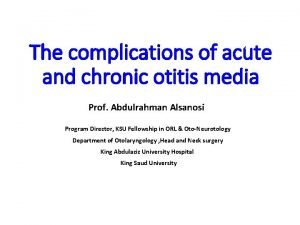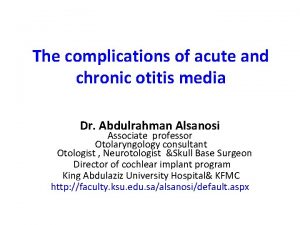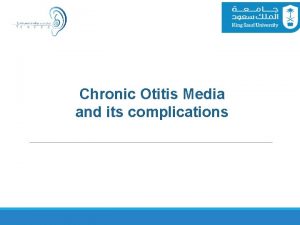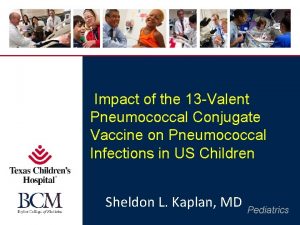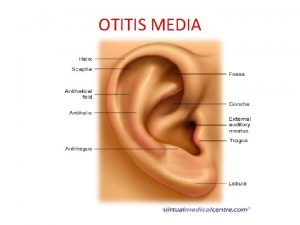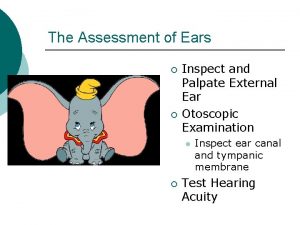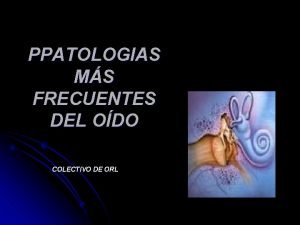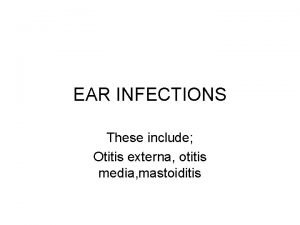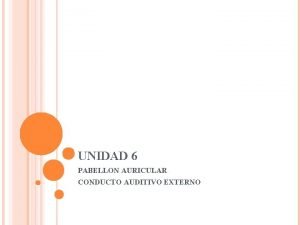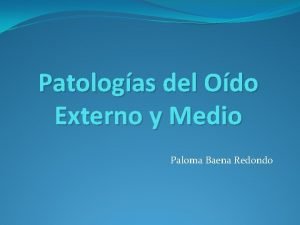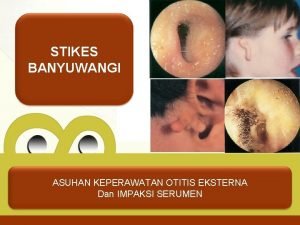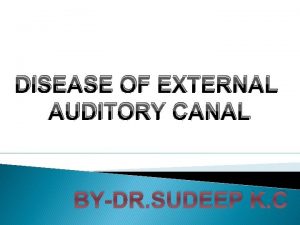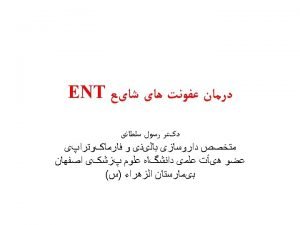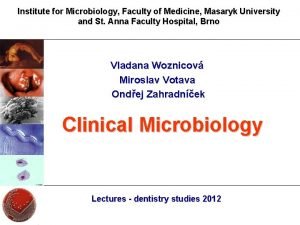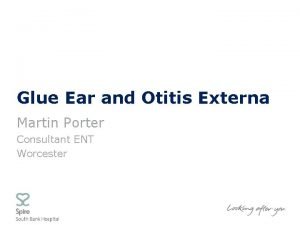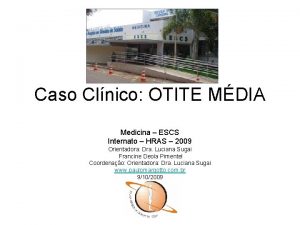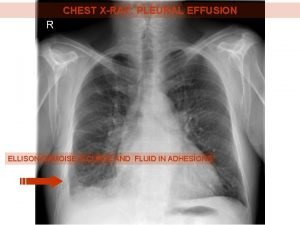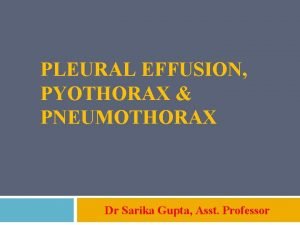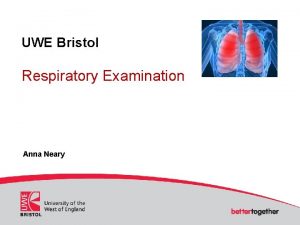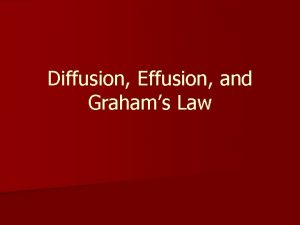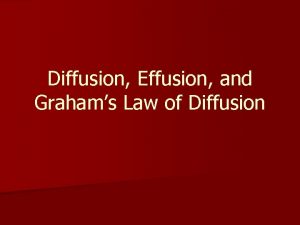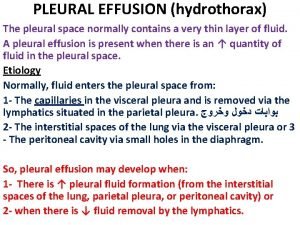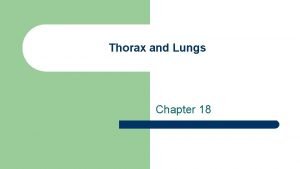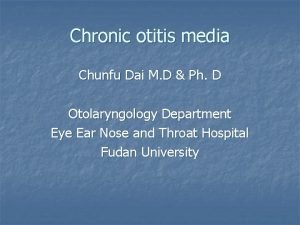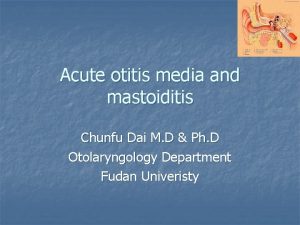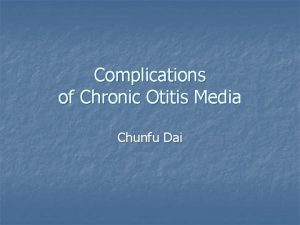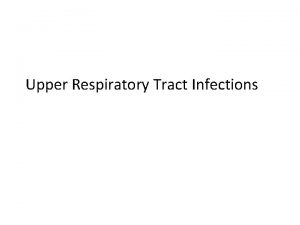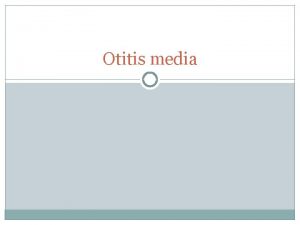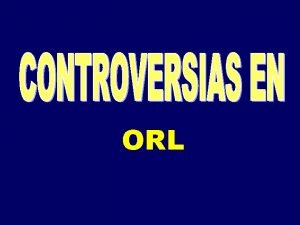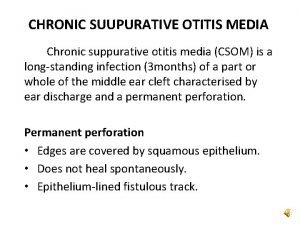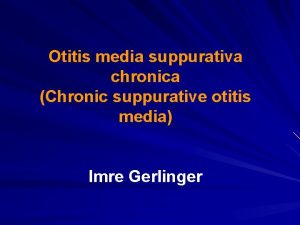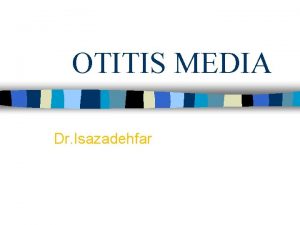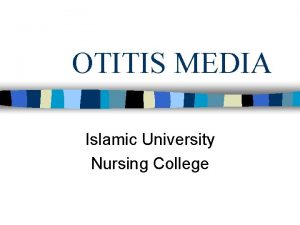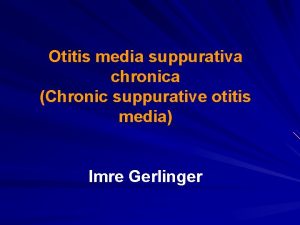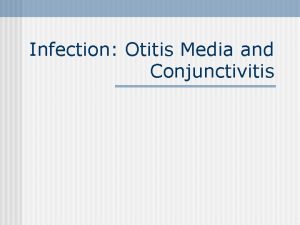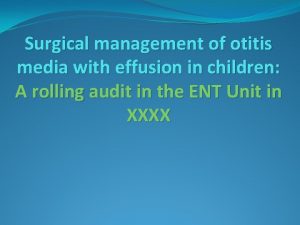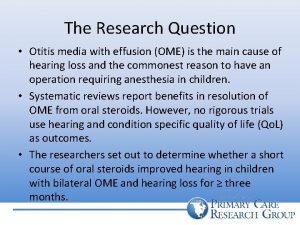Otitis media with effusion Chunfu Dai M D











































- Slides: 43

Otitis media with effusion Chunfu Dai M. D & Ph. D Otolaryngology Department Eye Ear Nose & Throat Hospital Fudan University

Background n n Otitis media is a multifactorial disease process involving immunology, infectious disease, anatomic considerations, social and socioeconomic issues, and genetics, among other factors. Approximately 70% of children below the age of 3 will develop an episode of otitis media.

Background n n 65 -95% of children by the age of 7 years will experience one or more episodes of acute otitis media. It remains the commonest cause for visit to the doctor in the pediatric population.

Background n n n Myringotomy was performed in eighteenth and nineteenth centuries to treat otitis media. During the preantibiotic era, the primary concern was the potential for intracranial complications of acute otitis media In 1954, Armstrong’s reintroduction of the tympanostomy tube, after that, few true advances in the treatment of otitis media was developed.

Definition n OME is an inflammatory condition of the middle ear and mastoid air cell system characterized by accumulation of fluid in the middle ear without signs or symptoms of acute infection.

n Other names: Secretory otitis media, n Serous otitis media, n Glue ear, n Nonpurulent otitis media, n Catarrhal otitis media. n

Pathogenesis n Dysfunction of Eustachian tube n Obstruction of Eustachian tube n Mechanic obstruction n n Non mechanic obstruction n n enlarged adenoid, tumor, enlarged inferior turbinate Weakness of related muscle, Clearance and defense n Immotile cilia syndrome

Pathogenesis n Infection n PCR detects the middle ear fluid, positive findings was 70% S pneumonia, haemophalus influenzae, haemolytic streptocuccus Immunity n n Middle ear is a isolated immune system Inflammatory mediators Specific antibody, immunologic complex Antigen may from adenoid or nasopharygeal lymph

Classification of Otitis media n n Otitis meda with effusion: the presence of middle ear effusion. If the middle ear effusion is present for 8 weeks or longer, it is classified chronic otitis media with effusion

Microbiology of otitis media n n Bacteria can be isolated from one third of patient who have OME. The most common are S pneumonia, H influenzae, and M catarrhalis (using traditional culture method). By using PCR, these three bacteria were detected in approximately 70% of Chronic middle ear effusion.

Diagnosis n n It is usually asymptomatic. Hearing loss n n n Kid can not concentrate himself Turn on TV in loudness If one ear is normal, the above symptoms will be ignored Fullness Otalgia Tinnitus

Diagnosis n The diagnosis is made at physical exam. n n n TM may retracted, dull, and opaque. The color of TM may range from light pink to amber even dark blue. The presence of air bubbles or air fluid levels makes the diagnosis more evident.


Diagnosis n Tympanometry n n Middle ear pressure more negative than -200 (type C) or a flat tympanometry curve (type B) is classified as a failure. A child fail test without marked HL (less than 20 d. B) should be retest 2 months later. 10 -14% of patients with low compliance tympanograms have only tympanic membrane retraction or thickening without effusion. While occlusion of the probe by cerumen or the child’s crying can cause invalid results.


Diagnosis n Hearing test n n n Rinne test: negative Audiogram: conductive hearing loss, no more than 40 d. B Tympanogram: B type or C type Lateral nasopharyngeal radiograph: hypertroph of adenoid Nasopharyngeal exam: to exclude spaceoccupation lesion



Differentiated diagnosis n Nasopharyngeal carcinoma: n n n Unilateral OME EBV-VCA-Ig. A Nasoendoscope CT or MRI Biopsy CSF (cerebrospinal fluid) leakage n n n Head trauma Meningitis CT or MRI

Differentiated diagnosis n Perilymphatic fluid fistula n n Secondary to stapes surgery or barotrauma Vertigo Hearing test: sensorineural hearing loss or mixed hearing loss Cholestrol granuloma (heamotympanum) n n n Advanced stage of OME Tympanic membrane: blue CT: soft tissue in mastoid or middle cavity

Differentiated diagnosis n Atelectatic Otitis media Sequela of OME n Conductive hearing loss n TM contacts with ossicular chain, promotory n


Diagnosis of otitis media n Differentiate diagnosis of AOM and OME will benefit our treatment, as the latter condition is usually not treated unless it becomes chronic

Diagnosis of otitis media n n n OME is a relatively asymptomatic middle ear effusion. Pneumatic otoscope frequently shows either a retracted or concave tympanic membrane. In addition, an air-fluid level or bubbles, or both may be observed through a translucent tympanic membrane.

Managements n Principles: discharge middle fluid n Drainage, ventilation n Eliminate pathogenesis n

Managements n Non surgical treatment Antibiotics n Steroid n Improvement of nose congestion n

Managements n Surgical treatment n n Tympanocentesis Myrigotomy Tympanotomy with PT mastoidectomy

Management of AOM n alternative medical treatment Corticosteroid (orally or intranasally), Antihistamine, decongestants n Orally corticosteroid and intranasally corticosteroid help clear chronic middle ear effusion. However, there is no evidence of efficacy in treatment of AOM. n Antihistamine and decongestants are used in the treatment of OME, it does not benefit AOM. n Children who have nasal congestion and allergic rhinitis there may be a role for these preparation.

Otitis media with effusion n The nature history of this disease is for spontaneous resolution in the majority of case More the 80% resolution by 2 month. It is the small number of children who continue to have effusion after 2 -3 months that are concern. n A trial of antibiotics would be appear to be appropriate in those children who have not received antibiotics recently. n OME is probably underdiagnosis. n

Otitis media with effusion n Chronic OME is defined as an effusion persisting for more than 3 months duration. A dense effusion typically may confer up to a 30 d. B hearing loss. Chronic OME may have a role in development of retraction pockets, ossicular chain erosion, and cholesteatoma formation.

Otitis media with effusion n Meta-analyses have come to conclusion that antibiotics have a small but distinct advantage over placebo in the treatment of persistent OME. When the effusion is chronic, surgical intervention should be considered, especially when antibiotic therapy fail. The primary surgical therapy remains placement of tympanostomy tubes for pressure equalization and drainage of middle ear.

Surgical treatment for otitis media n Placement of tympanostomy tubes. Middle ear effusion for more than 3 months or more. n OME associated with hearing loss of >30 d. B n Chronic severe TM retraction. n Impending intracranial complication n Recurrent otitis media with more than 3 episode within a 6 months period, or more than 4 episode within a 12 month period. n


Surgical treatment for otitis media n Adenoidectomy n indications for adenoidectomy Children with chronic otitis media who are candidates for tympanostomy tube placement n Children have symptoms for chronic adenoid hypertrophy, n Children require multiple sets of tympanostomy tube. n n It has been demonstrated that adenoidectomy may accelerate the resolution of chronic otitis media regardless of the size of the adenoid pad.

Surgical treatment for otitis media n Adenoidectomy With significant risks in children younger than 3 years of age that usually outweight its benefit. n Adenoidectomy be a consideration in the child older than 3 years of age at the time of insertion of a second set of tube. n

Surgical treatment for otitis media n Laser-assisted myringotomy (background) n n It has been advocated for the management of acute otitis media (unresponsive to medical management) and chronic otitis media with effusion, barotrauma, transtympanic inner ear perfusion. A history of allergies, the presence of a thick tympanic membrane and or high viscocity fluid are all contraindications for laser assisted tympanostomy

Surgical treatment for otitis media It can provide symptom relief and avoid placement of tympanostomy tube by alleviating infection and inflammation or improving middle ear ventilation. n Fenestration creates a round opening in the TM within a a fraction of a second and is usually bloodless. It generally last 2 -4 weeks n

Surgical treatment for otitis media n Laser-assisted myringotomy (technique requirement) Spot size ranged from 1. 8 -2. 8 mm and power from 7 -22 w, in general, thicker tympanic membranes required higher power or more than 1 laser discharge. n Topic anesthesia in an office setting and general anesthesia in operating room or office -based procedure. n

Surgical treatment for otitis media n Laser-assisted myringotomy (related results) n n n 2. 4 and 2. 6 mm spot size resulted in a greater percentage of patent fenestrations, long duration of fenestration was associated with higher cure rate Age of patient, type of fluid, wattage, preoperative tympanogram, or quadrant of TM undergoing fenestration are not predictors for duration of fenestration patency. .

Surgical treatment for otitis media The incidence of cure at 90 days for is greater than 60%, and the incidence of cure for OM treated in conjunction with adenoidectomy is greater than 80%. n Reduced risk and cost, and more effective and satifaction from parents n

Prognosis


 Acute inflammation
Acute inflammation Serous otitis media
Serous otitis media Kode icd 10 tinitus
Kode icd 10 tinitus Classification of otitis media
Classification of otitis media Tympanosclerosis
Tympanosclerosis Clasificación de la otitis media
Clasificación de la otitis media Aom vs ome
Aom vs ome Ligamentos timpanomaleolares
Ligamentos timpanomaleolares Suppurative otitis media
Suppurative otitis media Myringotomy nursing interventions
Myringotomy nursing interventions Otitis media otoscope
Otitis media otoscope Clasificación de la otitis media
Clasificación de la otitis media Otitis media ppt
Otitis media ppt Complications of otitis media
Complications of otitis media Nonsuppurative otitis media
Nonsuppurative otitis media Pediatr infect dis j
Pediatr infect dis j Otitis media wiki
Otitis media wiki Adhesive otitis media
Adhesive otitis media Nursing diagnosis for otitis media slideshare
Nursing diagnosis for otitis media slideshare Rinne weber
Rinne weber Clasificación de la otitis media
Clasificación de la otitis media Otitis media ppt
Otitis media ppt Otitis externa difusa
Otitis externa difusa Otitis externa circunscrita
Otitis externa circunscrita Askep otitis eksterna
Askep otitis eksterna Aumentativo de ropero
Aumentativo de ropero Otitis
Otitis Myringitis bullosa haemorrhagica
Myringitis bullosa haemorrhagica Otitis eksterna difusa icd 10
Otitis eksterna difusa icd 10 Acute diffuse otitis externa
Acute diffuse otitis externa Patho
Patho Differential diagnosis of otitis externa
Differential diagnosis of otitis externa Scalp salinizado
Scalp salinizado Ellis curve
Ellis curve Light's criteria
Light's criteria Tactile fremitis
Tactile fremitis Define diffusion and effusion
Define diffusion and effusion The passage of gas under pressure through a tiny opening
The passage of gas under pressure through a tiny opening Effusion definition
Effusion definition Root of lung anatomy
Root of lung anatomy Diffusion vs effusion
Diffusion vs effusion Phase changes of matter
Phase changes of matter Pleural effusion hydrothorax
Pleural effusion hydrothorax Decreased tactile fremitus
Decreased tactile fremitus
